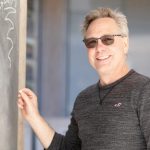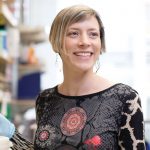Sustainability Salk Style
Salk and Kahn’s collaborative genius resulted in a building that isn’t just an architectural masterpiece drawing admirers from across the globe, but it is also the very embodiment of sustainable principles. Environmentally the Institute was, and continues to be, ahead of its time by using sustainable practices that cut its carbon footprint.
Kahn chose materials for the Institute that he thought would endure–concrete, steel and teak. But equally important to the Institute’s durability is what Salk called “an investment in flexibility.” This flexibility has enabled the Institute to adapt to the ever-changing needs of science and technology, while conserving natural resources.
ENERGY
More than 2,300 photovoltaic panels cover 100 percent of available roof space on the Institute’s main buildings, providing almost half a megawatt of power on the sunniest days-the energy equivalent of powering nearly 400 homes.
The Institute’s four electric-vehicle charging stations are kept busy by the several dozen electric cars owned by Salk faculty and staff.
WATER
A mix of California native plants and other drought-tolerant vegetation reduces the amount of water needed for landscaping. Additionally, tree trimmings are recycled and used as chippings and compost around the grounds to help retain precious moisture in the soil.
A 250-thousand gallon underground cistern collects rainwater to replenish the “River of Life” and the fountain at its west end.
Inside the buildings, water-conserving faucets are standard.
SUSTAINABLE RESTORATION
Since 2003, the Institute has incorporated sustainable design strategies for renovation and construction projects. The Institute’s iconic teak window-walls, which needed attention after 50 years of exposure to the elements, were painstakingly restored in 2017 in collaboration with the Getty Conservation Institute, preserving 75 percent of the original hard-to-source wood.
GREEN ROOFS
What looks like lawns on the north and south sides of the Institute are actually green roofs over Salk’s central plant and other underground facilities. Green roofs offer many environmental benefits, including preserving roof materials from life-shortening exposure to sunlight, reducing rainwater runoff (which can pollute waterways and burden sewers) and improving air quality by trapping dust and other airborne particles. They also provide spaces for picnics, volleyball, soccer and other activities.
GREEN PRODUCTS AND PARTNERS
The Institute looks at purchasing “green” products as a first choice. For example, the Facilities Department selects hand soap and cleaning products that are certified green, biodegradable and nonpolluting, so that they can go into the waste stream without causing environmental damage.
Salk’s landscaping contractor, Heaviland Landscape Management, uses quiet, non-polluting, electric mowers and blowers to keep the Institute’s surroundings immaculate.
Paper, plastic and battery recycling is practiced Institute-wide.
LIGHT
Kahn’s ingenious design included large windows and “light wells” to take advantage of natural daylight and reduce the need for artificial illumination. Today, the labs are additionally fitted with efficient, motion-sensing LED lighting, so that electricity is not wasted illuminating empty spaces whether day or night.
Featured Stories
 Gerald Shadel explores stressed-out mitochondriaInside Salk sat down with Shadel to find out how he became interested in mitochondria, what he is driven by scientifically and what he has learned about aging along the way.
Gerald Shadel explores stressed-out mitochondriaInside Salk sat down with Shadel to find out how he became interested in mitochondria, what he is driven by scientifically and what he has learned about aging along the way. The science of agingWhat we know about longevity so far: Minimizing smoking, obesity and overeating while maximizing exercise and social interactions seem to correspond to longer and healthier lives, but not always. While many factors have been touted as panaceas for extending life–everything from adhering to a Mediterranean diet to regularly imbibing red wine–a “fountain of youth” has remained stubbornly elusive.
The science of agingWhat we know about longevity so far: Minimizing smoking, obesity and overeating while maximizing exercise and social interactions seem to correspond to longer and healthier lives, but not always. While many factors have been touted as panaceas for extending life–everything from adhering to a Mediterranean diet to regularly imbibing red wine–a “fountain of youth” has remained stubbornly elusive. Lillian Eichner: Reading the clues to fight cancerEichner began studying cancer while pursuing her PhD at McGill University in Montreal. She was drawn to the Salk Institute for her postdoctoral studies because Reuben Shaw, director of the Salk Cancer Center and a professor in Salk’s Molecular and Cell Biology Laboratory, has taken a new approach to cancer by studying the metabolic pathways of deadly tumors.
Lillian Eichner: Reading the clues to fight cancerEichner began studying cancer while pursuing her PhD at McGill University in Montreal. She was drawn to the Salk Institute for her postdoctoral studies because Reuben Shaw, director of the Salk Cancer Center and a professor in Salk’s Molecular and Cell Biology Laboratory, has taken a new approach to cancer by studying the metabolic pathways of deadly tumors.




















































